Fluid-Rock Interactions in a Paleo-Geothermal Reservoir (Noble Hills Granite, California, USA). Part 2: The Influence of Fracturing on Granite Alteration Processes and Fluid Circulation at Low to Moderate Regional Strain
Abstract
:1. Introduction
- Characterize the relations among the varying amounts of strain, fracture densities, and alteration degrees at the NH scale, as well as the sample scales through the case studies.
- Characterize the variations in (1) chemical elements concentrations; (2) calcite content; (3) porosity; and (4) temperature condition variations when approaching fracture zones.
- Identify the different fluid circulation episodes through the granite body.
2. Geological Setting
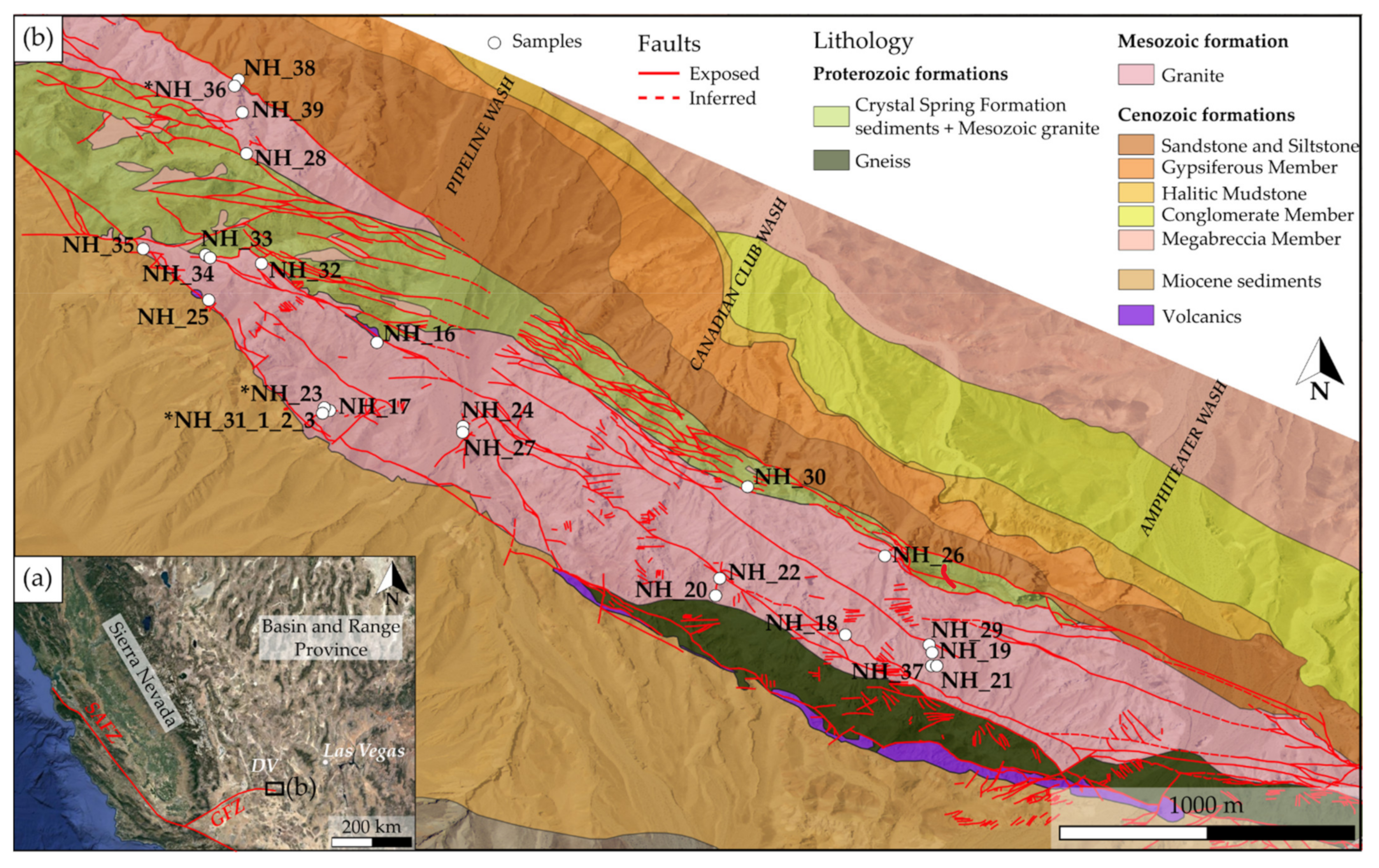
3. Materials and Methods
3.1. Material and Sample Selection
3.2. Methods
3.2.1. Fracture Network Parameters
3.2.2. Petrographic Characterization
3.2.3. X-ray Diffraction (XRD)
3.2.4. Manocalcimetry
3.2.5. Ethanol Saturation Porosimetry
3.2.6. Bulk Rock Geochemical Analyzes
3.2.7. Mass-Balance Using Gresens’ Method
4. Results
4.1. Noble Hills Structural Overview
4.2. Petrographic Description
- The second pattern (Figure 3b) shows the presence of dioctahedral vermiculite. It is characterized by a peak at 14.32Å in air-dried condition, which slightly swells up to 14.59Å after glycol solvation and slightly collapses to 12.26Å after heating. It was identified only in samples NH_24, NH_26, and NH_33, where it is associated to illite and kaolinite.
4.3. Fracturing and Fluid Circulation
4.3.1. Opening Related Structures with Minimum Shear Displacement
4.3.2. Infill of Fractures Developed with a Confirmed Lateral Shear Displacement
- Petrographic and petrophysical characterization: the brecciated vein presents a large variety of mineralogical phases. As shown in Figure 7a, this zone shows a carbonate matrix containing clasts of granite, which overprints a brecciated quartz vein remnant showing an undulatory extinction but no evidence of dynamic recrystallization. The carbonate matrix is complex, composed of several phases (Figure 9a–g).
- Phase 1 is composed of calcite veins crosscutting the quartz. These veins, appearing as a single phase under SEM and optical microscope (Figure 9a,c), present two phases under cathodoluminescence (CL): a dark phase (Cal A) in the center of the vein and an orange bright phase (Cal B) (Figure 9b,d). Cal B phase seems to dissolve or corrode the Cal A phase (Figure 9b,d). A zonation corresponding to calcite growth halos are visible in the phase A, which are used as weakness zones in which the phase B can penetrate by dissolving the phase A.
- Phase 2 is composed of a matrix rich in carbonates (calcite, dolomite, ankerite) transported clasts of quartz, K-feldspars and few biotite, but also presents barite precipitation patches (Figure 9e). This phase crosscuts the quartz and the calcite veins.
- Phase 3 consists again of calcite veins. However, they crosscut the whole rock, and appear as a dark single phase (Cal C) under CL (Figure 9b).
- Spatial fracture distribution: the spatial fracture distribution analysis was realized based on data from [42]. One scanline was realized through the sample in order to evaluate the evolution of the fracture distribution and density (Table 2, Figure 10a). The cumulative frequency against the fractures projected position presented in Figure 10b shows a fracture frequency slowly increasing, as well as a fracture cluster. The Cv of 1.03 indicates a random arrangement of the fractures along the scanline (Figure 10c). A fracture density of 342 fracs/m was compiled (Figure 10c).
- Petrographic and Petrophysical Characterization
- Spatial fracture distribution: two scanlines were realized in the granitic part of the sample NH_23 to evaluate the fracture arrangement from the vein towards the host rock (Figure 12a). The spatial analysis is summarized in Table 2. Fracture distributions presented in Figure 12b,c for each scanline show an evolution in two steps of the fracture cumulative frequency (Figure 12b).
- Petrographic and petrophysical characterization: the vein of the sample NH_23 consists of two parts. The major part is mainly composed of quartz, few feldspars, and oxide minerals having no CPO. Ankerite veinlets crosscut it, and are also intersected by calcite veinlets (Figure 14a,b). This vein includes clasts of carbonates having the same characteristics as the carbonate vein at the contact with the granite (Figure 12b). This thin carbonate vein is composed of ankerite layers and granite lenses (Figure 14c). By zooming in on the ankerite layer, some part of it appears as lenses with automorphic crystals in the swell, which are crushed and stretched through the pinches (Figure 14d). Granite is pinched between these ankerite layers. Quartz clasts present in the granite lenses show an undulatory extinction, as well as some evidences of subgrain rotation phenomena. Carbonates can deform plastically and accumulate large amount of strain at relatively low P–T conditions, from a minimum temperature of 180 °C [78,79,80,81]. Quartz crystal plastic deformation is dominant from 600 °C [82]. Hence, in the present situation, carbonates accommodate large amounts of deformation by means of crystal plasticity, while granite is being deformed by cataclastic flow, i.e., a process accommodated by brittle processes. A localized and significant amount of deformation occurred in this vein. The major vein of this sample is thus composed of (1) a highly deformed zone made of ankerite and granite lenses and (2) a siliceous vein, which contains clasts of similar composition to the carbonate vein. We suggest that the carbonate vein was the first event, which was intensively deformed, and then intersected by the siliceous vein, tearing off pieces of the carbonate vein. Calcite and ankerite veins identified in Figure 14a,b intersect the carbonate vein and the siliceous vein.
4.4. Geochemical Analyses
4.5. Calcite Content
4.6. Porosity and Mass-Balance
4.7. Temperature Conditions
5. Discussion
5.1. Argillic Alteration Dominance
- The propylitic alteration, which is an early stage of alteration affecting pervasively the granite during the cooling of the pluton [83]. It involves mainly the formation of corrensite and epidote considered as the major indicators of the propylitic alteration [19,22,84]. Only plagioclase and biotite are partially affected.
- The argillic alteration, associated with fluid circulation through a fracture network. Thus, the argillic alteration is also called “vein” alteration [13,21,85]. It is characterized by (1) a high water/rock ratio in the fractures/veins walls, due to fluid circulating within the fracture network [20,21,24,86,87,88,89]; and (2) illite + kaolinite + illite/smectite mixed layers + carbonates + oxides replacing plagioclase, biotite and, more rarely, partially K-feldspar [19]. Fractures enhance the fluid circulation and, thus, the fluid–rock interaction. Alteration gradients are visible, increasing toward the fracture (Figure 7a, Figure 9h–k, Figure 12a and Figure 14e,f). An alteration zoning around microfractures is also presented in Figure 6f,g, which could correspond to a time dependent process controlled by a sequence of interrelated mineral reactions [15].
5.2. Thermal Evolution toward Fracture Zones
5.3. A Multi-Stage Paleo-Fluid Circulation
- Quartz veins resulting in the precipitation of secondary quartz due to primary silicate partial dissolution.
- Illite veinlets, which have different behaviors, according to the mineral crossed. Indeed, as presented by [19,97], plagioclase is the main pathway for fluid flow due to their abundance in the rock and to dissolution pit porosity, allowing the interconnection between the pores. In quartz and K-feldspar; however, only microfractures create the porosity allowing the fluid to circulate. This explains why veinlets look like straight lines in quartz and K-feldspar and are twisted and blurred lines in altered plagioclase. Illite veinlets can be contemporary to kaolinite veinlets.
- A dolomitic brecciated vein embedding essentially quartz clasts, such as in sample NH_31.
- Carbonate veins with different compositions: contemporary ankerite/dolomite veins, intersected by siderite veins and the whole intersected by later calcite veins. They are preferentially oriented NW–SE, according to the direction of the NH. It is suggested that the fluids, having precipitated these carbonate veins, have circulated through the fracture network formed by the activity of the SDVFZ.
- A carbonate brecciated vein that is likely to have transported clasts of quartz, K-feldspar, and biotite, and is presenting precipitations of barite. This phase, but also barite itself, is only present in sample NH_31. This phase was probably due to a later event that reactivated the main fracture composing the sample and let a new fluid circulate.
- Calcite veins, as shown in the sample NH_31, which are of a different compositions from generation 4.
5.4. Fluid Circulation and Argillic Alteration Effects on Petrographic and Petrophysical Behavior
5.5. Relation among Fluid Circulation, Alteration, and Fracture Density
- The fluid interacts with the surrounding rock, altering it pervasively, and fractures are sealed by secondary minerals (Figure 20a,b). Those veins can be reactivated by shearing [103]. Thus, it creates a brecciated vein (e.g., NH_31) or even a mylonite (e.g., NH_23), developing an alteration gradient. Sample NH_23 shows that mylonitic deformation appears at low to moderate regional strain when carbonates are involved. Fault reactivation tends to cause a mineral fill breakage and reopens the fracture [2,104].
- Open fractures let fluid circulate without interaction with the surrounding rock. Shearing creates a breccia without further alteration within the granite, such as in NH_36 (Figure 19).
5.6. Implication of Alteration in Terms of Geothermal Reservoir Properties
6. Conclusions
- NH_31 shows a reactivated vein giving a brecciated vein (quartz and granitic clasts in a carbonate matrix), which induced no fracture gradient in the surrounding porphyritic granite, but developed an alteration gradient.
- NH_23 shows a carbonate mylonite creeping around deformed granite lenses, which induced a fracture gradient, as well as an alteration gradient in the surrounding porphyritic granite.
Author Contributions
Funding
Data Availability Statement
Acknowledgments
Conflicts of Interest
References
- Williams, C.F.; Reed, M.J.; Anderson, A.F. Updating the Classification of Geothermal Resources. In Proceedings of the Thirty Sixth Workshop on Geothermal Reservoir Engineering Stanford University, Stanford, CA, USA, 31 January–2 February 2011. [Google Scholar]
- Gillespie, P.A.; Holdsworth, R.; Long, D.; Williams, A.; Gutmanis, J. Introduction: Geology of fractured reservoirs. J. Geol. Soc. 2021, 178, 2020–2197. [Google Scholar] [CrossRef]
- Gentier, S.; Hopkins, D.; Riss, J. Role of fracture geometry in the evolution of flow paths under stress. In Geophysical Monograph Series; Faybishenko, B., Witherspoon, P.A., Benson, S.M., Eds.; American Geophysical Union: Washington, DC, USA, 2000; Volume 122, pp. 169–184. ISBN 978-0-87590-980-6. [Google Scholar]
- Curewitz, D.; Karson, J.A. Structural settings of hydrothermal outflow: Fracture permeability maintained by fault propagation and interaction. J. Volcanol. Geotherm. Res. 1997, 79, 149–168. [Google Scholar] [CrossRef]
- Dezayes, C.; Lerouge, C. Reconstructing Paleofluid Circulation at the Hercynian Basement/Mesozoic Sedimentary Cover Interface in the Upper Rhine Graben. Available online: https://www.hindawi.com/journals/geofluids/2019/4849860/abs/ (accessed on 21 June 2019).
- Vidal, J.; Genter, A. Overview of naturally permeable fractured reservoirs in the central and southern Upper Rhine Graben: Insights from geothermal wells. Geothermics 2018, 74, 57–73. [Google Scholar] [CrossRef]
- Callahan, O.A.; Eichhubl, P.; Olson, J.E.; Davatzes, N.C. Fracture Mechanical Properties of Damaged and Hydrothermally Altered Rocks, Dixie Valley-Stillwater Fault Zone, Nevada, USA. J. Geophys. Res. Solid Earth 2019, 124, 4069–4090. [Google Scholar] [CrossRef] [Green Version]
- Bauer, J.F.; Meier, S.; Philipp, S. Architecture, fracture system, mechanical properties and permeability structure of a fault zone in Lower Triassic sandstone, Upper Rhine Graben. Tectonophysics 2015, 647–648, 132–145. [Google Scholar] [CrossRef]
- Géraud, Y.; Rosener, M.; Surma, F.; Place, J.; Le Garzic, É.; Diraison, M. Physical properties of fault zones within a granite body: Example of the Soultz-sous-Forêts geothermal site. Comptes Rendus Geosci. 2010, 342, 566–574. [Google Scholar] [CrossRef]
- Géraud, Y.; Surma, F.; Rosener, M. Porosity Network of Soultz-Sous-Forets Granite: The Importance of the Damaged Zone around Faults and Fractures; Ecole et Observatoire des Sciences de la Terre: Strasbourg, France, 2005. [Google Scholar]
- Faulkner, D.; Jackson, C.; Lunn, R.; Schlische, R.; Shipton, Z.; Wibberley, C.; Withjack, M. A review of recent developments concerning the structure, mechanics and fluid flow properties of fault zones. J. Struct. Geol. 2010, 32, 1557–1575. [Google Scholar] [CrossRef]
- Long, J.C.S.; Witherspoon, P.A. The relationship of the degree of interconnection to permeability in fracture networks. J. Geophys. Res. Space Phys. 1985, 90, 3087–3098. [Google Scholar] [CrossRef]
- Ledésert, B.; Hebert, R.; Genter, A.; Bartier, D.; Clauer, N.; Grall, C. Fractures, hydrothermal alterations and permeability in the Soultz Enhanced Geothermal System. Comptes Rendus Geosci. 2010, 342, 607–615. [Google Scholar] [CrossRef]
- Kuncoro, G.B. Fluid-Rock Interaction Studies on an Enhanced Geothermal System in the Cooper Basin, South Australia. Ph.D. Thesis, University of Adelaide, Adelaide, SA, Australia, 2015. [Google Scholar]
- Turpault, M.-P.; Berger, G.; Meunier, A. Dissolution-precipitation processes induced by hot water in a fractured granite Part 1: Wall-rock alteration and vein deposition processes. Eur. J. Miner. 1992, 4, 1457–1476. [Google Scholar] [CrossRef]
- Dezayes, C.; Lerouge, C.; Innocent, C.; Lach, P. Structural control on fluid circulation in a graben system: Constraints from the Saint Pierre Bois quarry (Vosges, France). J. Struct. Geol. 2021, 146, 104323. [Google Scholar] [CrossRef]
- Dalmais, E.; Genter, A.; Trullenque, G.; Leoutre, E.; Leiss, B.; Wagner, B.; Mintsa, A.C.; Bär, K.; Rajsl, I. MEET Project: Toward the Spreading of EGS across Europe. In Proceedings of the European Geothermal Congress, Den Haag, The Netherlands, 11–14 June 2019. [Google Scholar]
- Trullenque, G.; Genter, A.; Leiss, B.; Wagner, B.; Bouchet, R.; Leoutre, E.; Malnar, B.; Bär, K.; Rajšl, I. Upscaling of EGS in Different Geological Conditions: A European Perspective. In Proceedings of the 43rd Workshop on Geothermal Reservoir Engineering Stanford University, Stanford, CA, USA, 12–14 February 2018. [Google Scholar]
- Klee, J.; Potel, S.; Ledésert, B.; Hébert, R.; Chabani, A.; Barrier, P.; Trullenque, G. Fluid-Rock Interactions in a Paleo-Geothermal Reservoir (Noble Hills Granite, California, USA). Part 1: Granite Pervasive Alteration Processes away from Fracture Zones. Geosciences 2021, 11, 325. [Google Scholar] [CrossRef]
- Ledésert, B.; Berger, G.; Meunier, A.; Genter, A.; Bouchet, A. Diagenetic-type reactions related to hydrothermal alteration in the Soultz-sous-Forêts granite, France. Eur. J. Miner. 1999, 11, 731–742. [Google Scholar] [CrossRef]
- Genter, A. Géothermie Roches Chaudes Sèches: Le Granite de Soultz-Sous-Forêts (Bas-Rhin, France): Fracturation Naturelle, Altérations Hydrothermales et Interaction Eau-Roche. Ph.D. Thesis, Université d’Orléans, Orléans, France, 1989. [Google Scholar]
- Traineau, H.; Genter, A.; Cautru, J.P.; Fabriol, H.; Chevremont, P. Petrography of the Granite Massif from Drill Cutting Analysis and Well Log Interpretation in the Geothermal HDR Borehole GPK1 (Soultz, Alsace, France). Geotherm. Sci. Technol. 1991, 3, 1–29. [Google Scholar]
- Meunier, A. Hydrothermal Alteration by Veins. In Origin and Mineralogy of Clays: Clays and the Environment; Velde, B., Ed.; Springer: Berlin/Heidelberg, Germany, 1995; pp. 247–267. ISBN 978-3-662-12648-6. [Google Scholar]
- Bonorino, F.G. Hydrothermal alteration in the front range mineral belt, colorado. GSA Bull. 1959, 70, 53–90. [Google Scholar] [CrossRef]
- Caine, J.S.; Bruhn, R.L.; Forster, C.B. Internal structure, fault rocks, and inferences regarding deformation, fluid flow, and mineralization in the seismogenic Stillwater normal fault, Dixie Valley, Nevada. J. Struct. Geol. 2010, 32, 1576–1589. [Google Scholar] [CrossRef]
- Norton, I. Two-stage formation of Death Valley. Geosphere 2011, 7, 171–182. [Google Scholar] [CrossRef]
- Dokka, R.K.; Travis, C.J. Role of the Eastern California Shear Zone in accommodating Pacific-North American Plate motion. Geophys. Res. Lett. 1990, 17, 1323–1326. [Google Scholar] [CrossRef]
- Stewart, J.H.; Ernst, W.G. Tectonics of the Walker Lane Belt, Western Great Basin: Mesozoic and Cenozoic Deformation in a Zone of Shear. Metamorph. Crustal Evol. West. United States 1988, 7, 683–713. [Google Scholar]
- Lifton, Z.M.; Newman, A.V.; Frankel, K.L.; Johnson, C.W.; Dixon, T.H. Insights into distributed plate rates across the Walker Lane from GPS geodesy. Geophys. Res. Lett. 2013, 40, 4620–4624. [Google Scholar] [CrossRef] [Green Version]
- Miller, M.M.; Johnson, D.J.; Dixon, T.H.; Dokka, R.K. Refined kinematics of the eastern California shear zone from GPS observations, 1993–1998. J. Geophys. Res. Space Phys. 2001, 106, 2245–2263. [Google Scholar] [CrossRef]
- Hill, M.L.; Troxel, B.W. Tectonics of Death Valley region, California. GSA Bull. 1966, 77, 435–438. [Google Scholar] [CrossRef]
- Burchfiel, B.C.; Stewart, J.H. “Pull-Apart” Origin of the Central Segment of Death Valley, California. GSA Bull. 1966, 77, 439–442. [Google Scholar] [CrossRef]
- Pavlis, T.L.; Trullenque, G. Evidence for 40–41 km of dextral slip on the southern Death Valley fault: Implications for the Eastern California shear zone and extensional tectonics. Geology 2021, 49, 767–772. [Google Scholar] [CrossRef]
- Rämö, T.O.; Calzia, J.P.; Kosunen, P.J. Geochemistry of Mesozoic plutons, southern Death Valley region, California: Insights into the origin of Cordilleran interior magmatism. Contrib. Miner. Pet. 2002, 143, 416–437. [Google Scholar] [CrossRef]
- Reinert, E. Low-Temperature Thermochronometry of the Avawatz Mountains, California: Implications for the Inception of the Eastern California Shear Zone. Ph.D. Thesis, University of Washington, Seattle, WA, USA, 2004. [Google Scholar]
- Chinn, L.D. Low-Temperature Thermochronometry of the Avawatz Mountains; Implications for the Eastern Terminus and Inception of the Garlock Fault Zone; University of Washington: Seattle, WA, USA, 2013; 48p. [Google Scholar]
- Spencer, J.E. Chapter 15: Late Cenozoic extensional and compressional tectonism in the southern and western Avawatz Mountains, southeastern California. In Geological Society of America Memoirs; Geological Society of America: Boulder, CO, USA, 1990; Volume 176, pp. 317–334. [Google Scholar]
- Niles, J.H. Post-Middle Pliocene Tectonic Development of the Noble Hills, Southern Death Valley, California. Ph.D. Thesis, San Francisco State University, San Francisco, CA, USA, 2016. [Google Scholar]
- Brady, R.H. Neogene stratigraphy of the Avawatz Mountains between the Garlock and Death Valley fault zones, southern Death Valley, California: Implications as to late Cenozoic tectonism. Sediment. Geol. 1984, 38, 127–157. [Google Scholar] [CrossRef]
- Troxel, B.W.; Butler, P.R. Rate of Cenozoic Slip on Normal Faults, South-Central Death Valley, California; Department of Geology, University of California: Berkeley, CA, USA, 1979. [Google Scholar]
- Klee, J.; Trullenque, G.; Ledésert, B.; Potel, S.; Hébert, R.; Chabani, A.; Genter, A. Petrographic Analyzes of Fractured Granites Used as An Analogue of the Soultz-Sous-Forêts Geothermal Reservoir: Noble Hills, CA, USA. In Proceedings of the World Geothermal Congress 2020+1, Reykjavik, Iceland, 24–27 October 2020. [Google Scholar]
- Chabani, A.; Trullenque, G.; Ledésert, B.; Klee, J. Multiscale Characterization of Fracture Patterns: A Case Study of the Noble Hills Range (Death Valley, CA, USA), Application to Geothermal Reservoirs. Geoscience 2021, 11, 280. [Google Scholar] [CrossRef]
- Castaing, C.; Rabu, D. Apports de La Géologie à La Recherche et à l’exploitation de Pierres de Taille (Roches Ornementales et de Construction). BULL BRGM 1981, 3, 1. [Google Scholar]
- Chabani, A.; Trullenque, G.; Klee, J.; Ledésert, B.A. Fracture Spacing Variability and the Distribution of Fracture Patterns in Granitic Geothermal Reservoir: A Case Study in the Noble Hills Range (Death Valley, CA, USA). Geosciences 2021, 11, 280. [Google Scholar] [CrossRef]
- Laubach, S.; Lamarche, J.; Gauthier, B.; Dunne, W.; Sanderson, D. Spatial arrangement of faults and opening-mode fractures. J. Struct. Geol. 2018, 108, 2–15. [Google Scholar] [CrossRef]
- Olson, J.E. Joint pattern development: Effects of subcritical crack growth and mechanical crack interaction. J. Geophys. Res. Space Phys. 1993, 98, 12251–12265. [Google Scholar] [CrossRef]
- Bisdom, K.; Gauthier, B.; Bertotti, G.; Hardebol, N. Calibrating discrete fracture-network models with a carbonate three-dimensional outcrop fracture network: Implications for naturally fractured reservoir modeling. AAPG Bull. 2014, 98, 1351–1376. [Google Scholar] [CrossRef]
- Gillespie, P.; Howard, C.; Walsh, J.; Watterson, J. Measurement and characterisation of spatial distributions of fractures. Tectonophysics 1993, 226, 113–141. [Google Scholar] [CrossRef]
- Priest, S.; Hudson, J. Discontinuity spacings in rock. Int. J. Rock Mech. Min. Sci. Géoméch. Abstr. 1976, 13, 135–148. [Google Scholar] [CrossRef]
- Sanderson, D.J.; Peacock, D.C. Line sampling of fracture swarms and corridors. J. Struct. Geol. 2019, 122, 27–37. [Google Scholar] [CrossRef]
- Terzaghi, R.D. Sources of Error in Joint Surveys. Géotechnique 1965, 15, 287–304. [Google Scholar] [CrossRef]
- Zhou, W.; Wang, Z.L. Scanning Microscopy for Nanotechnology: Techniques and Applications; Springer Science & Business Media: Berlin/Heidelberg, Germany, 2007; ISBN 978-0-387-39620-0. [Google Scholar]
- Kanda, K. Energy Dispersive X-Ray Spectrometer. U.S. Patent 5,065,020, 1991. [Google Scholar]
- Götze, J. Cathodoluminescence in Applied Geosciences. In Cathodoluminescence in Geosciences; Pagel, M., Barbin, V., Blanc, P., Ohnenstetter, D., Eds.; Springer: Berlin/Heidelberg, Germany, 2000; ISBN 978-3-662-04086-7. [Google Scholar]
- Götze, J. Application of Cathodoluminescence Microscopy and Spectroscopy in Geosciences. Microsc. Microanal. 2012, 18, 1270–1284. [Google Scholar] [CrossRef] [PubMed] [Green Version]
- Kretz, R. Symbols for Rock-Forming Minerals. Am. Mineral. 1983, 68, 277–279. [Google Scholar]
- Schmidt, D.; Schmidt, S.T.; Mullis, J.; Mählmann, R.F.; Frey, M. Very low grade metamorphism of the Taveyanne formation of western Switzerland. Contrib. Miner. Pet. 1997, 129, 385–403. [Google Scholar] [CrossRef]
- Kisch, H.J. Illite crystallinity: Recommendations on sample preparation, X-ray diffraction settings, and interlaboratory samples. J. Metamorph. Geol. 1991, 9, 665–670. [Google Scholar] [CrossRef]
- Mählmann, R.F.; Frey, M. Standardisation, calibration and correlation of the Kübler-index and the vitrinite/bituminite reflectance: An inter-laboratory and field related study. Swiss J. Geosci. 2012, 105, 153–170. [Google Scholar] [CrossRef]
- Moore, D.M.; Reynolds, R.C. X-ray Diffraction and the Identification and Analysis of Clay Minerals; Oxford University Press: New York, NY, USA, 1989. [Google Scholar]
- Starkey, H.C.; Blackmon, P.D.; Hauff, P.L. The Routine Mineralogical Analysis of Clay-Bearing Samples; U.S. G.P.O.: Washington, DC, USA, 1984. [Google Scholar]
- Kübler, B. La Cristallinite de l’illite et Les Zones Tout a Fait Superieures Du Metamorphisme. In Etages Tectoniques; La Baconniere: Boudry, Switzerland, 1967; pp. 105–121. [Google Scholar]
- Warr, L.; Mählmann, R.F. Recommendations for Kübler Index standardization. Clay Miner. 2015, 50, 283–286. [Google Scholar] [CrossRef]
- Kisch, H.J. Correlation between indicators of very low-grade metamorphism. In Low-Temperature Metamorphism; Frey, M., Ed.; Blackie and Son Ltd.: Glasgow, UK, 1987; pp. 227–300. [Google Scholar]
- Árkai, P.; Sassi, F.; Desmons, J. Very Low- to Low-Grade Metamorphic Rocks. In Metamorphic Rocks A Classification and Glossary Terms; Cambridge University Press: Cambridge, UK, 2003. [Google Scholar]
- Warr, L.N.; Cox, S.C. Correlating illite (Kübler) and chlorite (Árkai) “crystallinity” indices with metamorphic mineral zones of the South Island, New Zealand. Appl. Clay Sci. 2016, 134, 164–174. [Google Scholar] [CrossRef]
- Frey, M. Very low-grade metamorphism of clastic sedimentary rocks. In Low-Temperature Metamorphism; Frey, M., Ed.; Blackie: Glasgow, UK, 1987; pp. 9–58. [Google Scholar]
- Árkai, P.; Maehlmann, R.; Suchy, V.; Balogh, K.; Sykorová, I.; Frey, M. Possible Effects of Tectonic Shear Strain on Phyllosilicates: A Case Study from the Kandersteg Area, Helvetic Domain, Central Alps, Switzerland. TMPM Tschermaks Mineral. Petrogr. Mitt. 2002, 82, 273–290. [Google Scholar]
- Mullis, J.; Mählmann, R.F.; Wolf, M. Fluid inclusion microthermometry to calibrate vitrinite reflectance (between 50 and 270 °C), illite Kübler-Index data and the diagenesis/anchizone boundary in the external part of the Central Alps. Appl. Clay Sci. 2017, 143, 307–319. [Google Scholar] [CrossRef]
- Warr, L.N.; Rice, A.H.N. Interlaboratory standardization and calibration of day mineral crystallinity and crystallite size data. J. Metamorph. Geol. 1994, 12, 141–152. [Google Scholar] [CrossRef]
- Ledésert, B.; Hébert, R.L.; Grall, C.; Genter, A.; Dezayes, C.; Bartier, D.; Gérard, A. Calcimetry as a useful tool for a better knowledge of flow pathways in the Soultz-sous-Forêts Enhanced Geothermal System. J. Volcanol. Geotherm. Res. 2009, 181, 106–114. [Google Scholar] [CrossRef]
- White, A.F.; Schulz, M.S.; Lowenstern, J.B.; Vivit, D.V.; Bullen, T.D. The ubiquitous nature of accessory calcite in granitoid rocks: Implications for weathering, solute evolution, and petrogenesis. Geochim. Cosmochim. Acta 2005, 69, 1455–1471. [Google Scholar] [CrossRef]
- Dullien, F.A.L. Porous Media: Fluid Transport and Pore Structure; Academic Press: San Diego, CA, USA, 1979; ISBN 978-0-323-13933-5. [Google Scholar]
- Navelot, V.; Géraud, Y.; Favier, A.; Diraison, M.; Corsini, M.; Lardeaux, J.-M.; Verati, C.; de Lépinay, J.M.; Legendre, L.; Beauchamps, G. Petrophysical properties of volcanic rocks and impacts of hydrothermal alteration in the Guadeloupe Archipelago (West Indies). J. Volcanol. Geotherm. Res. 2018, 360, 1–21. [Google Scholar] [CrossRef]
- Gates, W.P.; Nefiodovas, A.; Peter, P. Permeability of an Organo-Modified Bentonite to Ethanol-Water Solutions. Clays Clay Miner. 2004, 52, 192–203. [Google Scholar] [CrossRef]
- Gresens, R.L. Composition-volume relationships of metasomatism. Chem. Geol. 1967, 2, 47–65. [Google Scholar] [CrossRef]
- Beaufort, D.; Baronnet, A.; Lanson, B.; Meunier, A. Corrensite; a single phase or a mixed-layer phyllosilicate in saponite-to-chlorite conversion series? A case study of Sancerre-Couy deep drill hole (France). Am. Miner. 1997, 82, 109–124. [Google Scholar] [CrossRef]
- Andrews, B.J.; Roberts, J.J.; Shipton, Z.K.; Bigi, S.; Tartarello, M.C.; Johnson, G. How do we see fractures? Quantifying subjective bias in fracture data collection. Solid Earth 2019, 10, 487–516. [Google Scholar] [CrossRef] [Green Version]
- Bestmann, M.; Kunze, K.; Matthews, A. Evolution of a calcite marble shear zone complex on Thassos Island, Greece: Microstructural and textural fabrics and their kinematic significance. J. Struct. Geol. 2000, 22, 1789–1807. [Google Scholar] [CrossRef]
- Burkhard, M. Ductile deformation mechanisms in micritic limestones naturally deformed at low temperatures (150–350 °C.). Geol. Soc. London Spéc. Publ. 1990, 54, 241–257. [Google Scholar] [CrossRef]
- Schmid, S.; Panozzo, R.; Bauer, S. Simple shear experiments on calcite rocks: Rheology and microfabric. J. Struct. Geol. 1987, 9, 747–778. [Google Scholar] [CrossRef]
- Stipp, M.; Kunze, K. Dynamic recrystallization near the brittle-plastic transition in naturally and experimentally deformed quartz aggregates. Tectonophysics 2008, 448, 77–97. [Google Scholar] [CrossRef]
- Glaas, C.; Patrier, P.; Vidal, J.; Beaufort, D.; Genter, A. Clay Mineralogy: A Signature of Granitic Geothermal Reservoirs of the Central Upper Rhine Graben. Minerals 2021, 11, 479. [Google Scholar] [CrossRef]
- Burnham, C.W. Facies and types of hydrothermal alteration. Econ. Geol. 1962, 57, 768–784. [Google Scholar] [CrossRef]
- Dubois, M.; Ledesert, B.; Potdevin, J.-L.; Vançon, S. Détermination des conditions de précipitation des carbonates dans une zone d’altération du granite de Soultz (soubassement du fossé Rhénan, France): L’enregistrement des inclusions fluides. Comptes Rendus l’Académie Sci. Ser. II A Earth Planet. Sci. 2000, 331, 303–309. [Google Scholar] [CrossRef]
- Marqués, J.M.; Matias, M.J.; Basto, M.J.; Carreira, P.M.; Aires-Barros, L.A.; Goff, F.E. Hydrothermal alteration of Hercynian granites, its significance to the evolution of geothermal systems in granitic rocks. Geothermics 2010, 39, 152–160. [Google Scholar] [CrossRef]
- Pauwels, H.; Fouillac, C.; Fouillac, A.-M. Chemistry and isotopes of deep geothermal saline fluids in the Upper Rhine Graben: Origin of compounds and water-rock interactions. Geochim. Cosmochim. Acta 1993, 57, 2737–2749. [Google Scholar] [CrossRef]
- Parneix, J.; Petit, J. Hydrothermal alteration of an old geothermal system in the Auriat granite (Massif Central, France): Petrological study and modelling. Chem. Geol. 1991, 89, 329–351. [Google Scholar] [CrossRef]
- Berger, G.; Velde, B. Chemical parameters controlling the propylitic and argillic alteration process. Eur. J. Miner. 1992, 4, 1439–1456. [Google Scholar] [CrossRef]
- Fulignati, P. Clay Minerals in Hydrothermal Systems. Minerals 2020, 10, 919. [Google Scholar] [CrossRef]
- Fordham, A.W. Weathering of Biotite into dioctahedral Clay Minerals. Clay Miner. 1989, 25, 51–63. [Google Scholar] [CrossRef]
- Kajdas, B.; Michalik, M.; Migoń, P. Mechanisms of granite alteration into grus, Karkonosze granite, SW Poland. Catena 2017, 150, 230–245. [Google Scholar] [CrossRef]
- Abad, I. Physical Meaning and Applications of the Illite Kübler Index: Measuring Reaction Progress in Low-Grade Metamorphism. In Diagenesis and Low-Temperature Metamorphism, Theory, Methods and Regional Aspects, Seminarios, Sociedad Espanola: Sociedad Espanola Mineralogia; University of Jaen: Jaen, Spain, 2007; pp. 53–64. [Google Scholar]
- Camacho, A.; McDougall, I.; Armstrong, R.; Braun, J. Evidence for shear heating, Musgrave Block, central Australia. J. Struct. Geol. 2001, 23, 1007–1013. [Google Scholar] [CrossRef]
- Środoń, J. Nature of mixed-layer clays and mechanisms of their formation and alteration. Annu. Rev. Earth Planet. Sci. 1999, 27, 19–53. [Google Scholar] [CrossRef]
- Bruhn, R.L.; Parry, W.T.; Yonkee, W.A.; Thompson, T. Fracturing and hydrothermal alteration in normal fault zones. Pure Appl. Geophys. 1994, 142, 609–644. [Google Scholar] [CrossRef]
- Sardini, P.; Ledesert, B.; Touchard, G. Quantification of Microscopic Porous Networks By Image Analysis and Measurements of Permeability in the Soultz-Sous-Forêts Granite (Alsace, France). In Fluid Flow and Transport in Rocks; Springer: Berlin/Heidelberg, Germany, 1997; pp. 171–189, Chapter 10. [Google Scholar]
- Liu, Y.; Xie, C.; Li, C.; Li, S.; Santosh, M.; Wang, M.; Fan, J. Breakup of the northern margin of Gondwana through lithospheric delamination: Evidence from the Tibetan Plateau. GSA Bull. 2019, 131, 675–697. [Google Scholar] [CrossRef]
- Chambefort, I.; Moritz, R.; von Quadt, A. Petrology, geochemistry and U–Pb geochronology of magmatic rocks from the high-sulfidation epithermal Au–Cu Chelopech deposit, Srednogorie zone, Bulgaria. Miner. Deposita 2007, 42, 665–690. [Google Scholar] [CrossRef] [Green Version]
- Glassley, W.; Crossey, L.; Montañez, I. Fluid–Rock Interaction. In Encyclopedia of Geochemistry; Springer Iinternational Publishing: Cham, Switzerland, 2016. [Google Scholar]
- Kadko, D.; Butterfield, D.A. The relationship of hydrothermal fluid composition and crustal residence time to maturity of vent fields on the Juan de Fuca Ridge. Geochim. Cosmochim. Acta 1998, 62, 1521–1533. [Google Scholar] [CrossRef]
- Hebert, R.L.; Ledesert, B.; Bartier, D.; Dezayes, C.; Genter, A.; Grall, C. The Enhanced Geothermal System of Soultz-sous-Forêts: A study of the relationships between fracture zones and calcite content. J. Volcanol. Geotherm. Res. 2010, 196, 126–133. [Google Scholar] [CrossRef]
- Dhansay, T.; Navabpour, P.; de Wit, M.; Ustaszewski, K. Assessing the reactivation potential of pre-existing fractures in the southern Karoo, South Africa: Evaluating the potential for sustainable exploration across its Critical Zone. J. Afr. Earth Sci. 2017, 134, 504–515. [Google Scholar] [CrossRef]
- Moir, H.; Lunn, R.; Shipton, Z.; Kirkpatrick, J. Simulating brittle fault evolution from networks of pre-existing joints within crystalline rock. J. Struct. Geol. 2010, 32, 1742–1753. [Google Scholar] [CrossRef]
- Laubach, S.E. Practical approaches to identifying sealed and open fractures. AAPG Bull. 2003, 87, 561–579. [Google Scholar] [CrossRef]
- Woodcock, N.H.; Dickson, J.A.D.; Tarasewicz, J.P.T. Transient permeability and reseal hardening in fault zones: Evidence from dilation breccia textures. Geol. Soc. London, Spéc. Publ. 2007, 270, 43–53. [Google Scholar] [CrossRef]
- Vidal, J.; Patrier, P.; Genter, A.; Beaufort, D.; Dezayes, C.; Glaas, C.; Lerouge, C.; Sanjuan, B. Clay minerals related to the circulation of geothermal fluids in boreholes at Rittershoffen (Alsace, France). J. Volcanol. Geotherm. Res. 2018, 349, 192–204. [Google Scholar] [CrossRef]
- Liotta, D.; Brogi, A.; Ruggieri, G.; Rimondi, V.; Zucchi, M.; Helgadóttir, H.M.; Montegrossi, G.; Friðleifsson, G. Ómar Fracture analysis, hydrothermal mineralization and fluid pathways in the Neogene Geitafell central volcano: Insights for the Krafla active geothermal system, Iceland. J. Volcanol. Geotherm. Res. 2020, 391, 106502. [Google Scholar] [CrossRef]
- Griffiths, L.; Heap, M.; Wang, F.; Daval, D.; Gilg, H.; Baud, P.; Schmittbuhl, J.; Genter, A. Geothermal implications for fracture-filling hydrothermal precipitation. Geothermics 2016, 64, 235–245. [Google Scholar] [CrossRef]
- Ito, H. Inferred role of natural fractures, veins, and breccias in development of the artificial geothermal reservoir at the Ogachi Hot Dry Rock site, Japan. J. Geophys. Res. Space Phys. 2003, 108. [Google Scholar] [CrossRef] [Green Version]
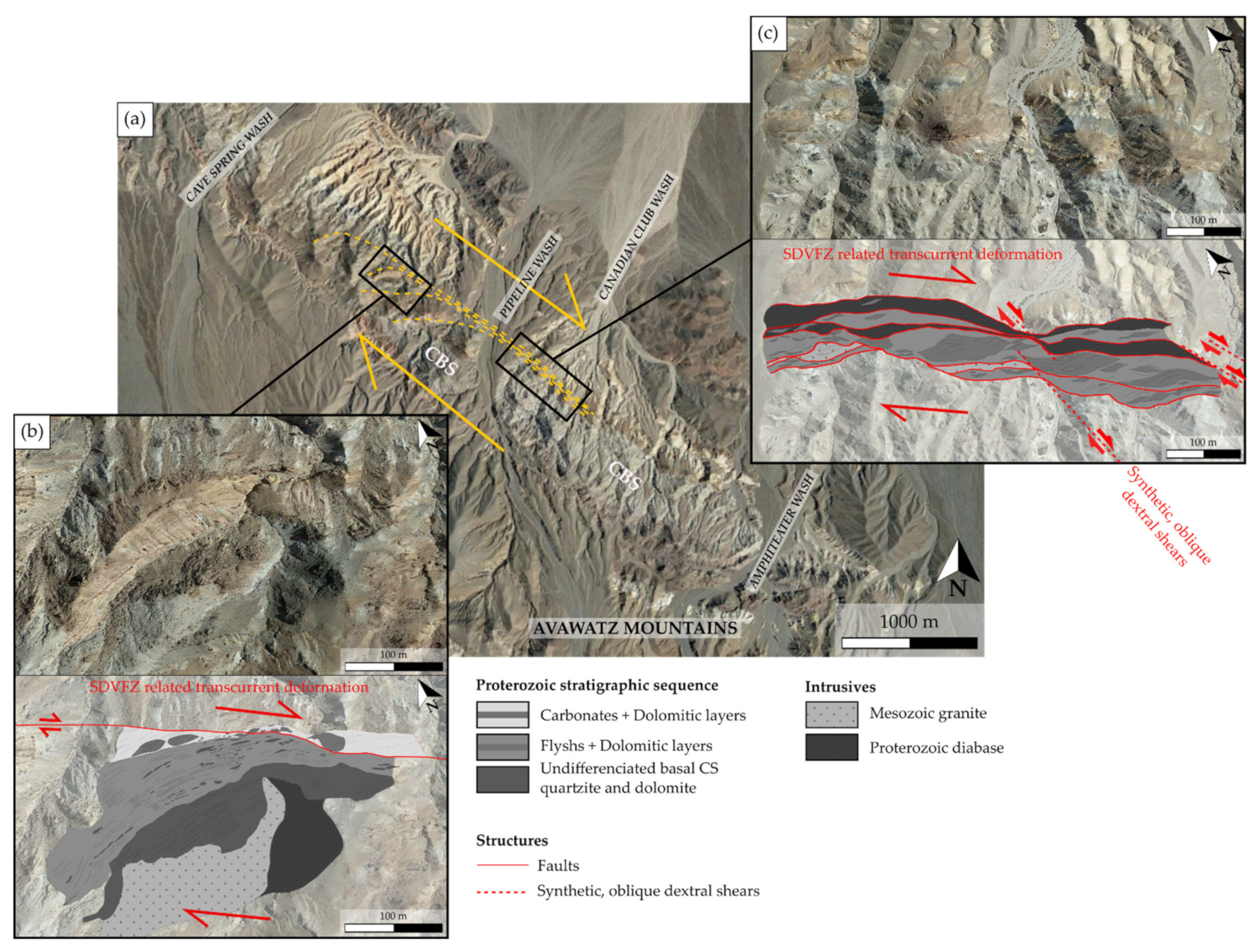


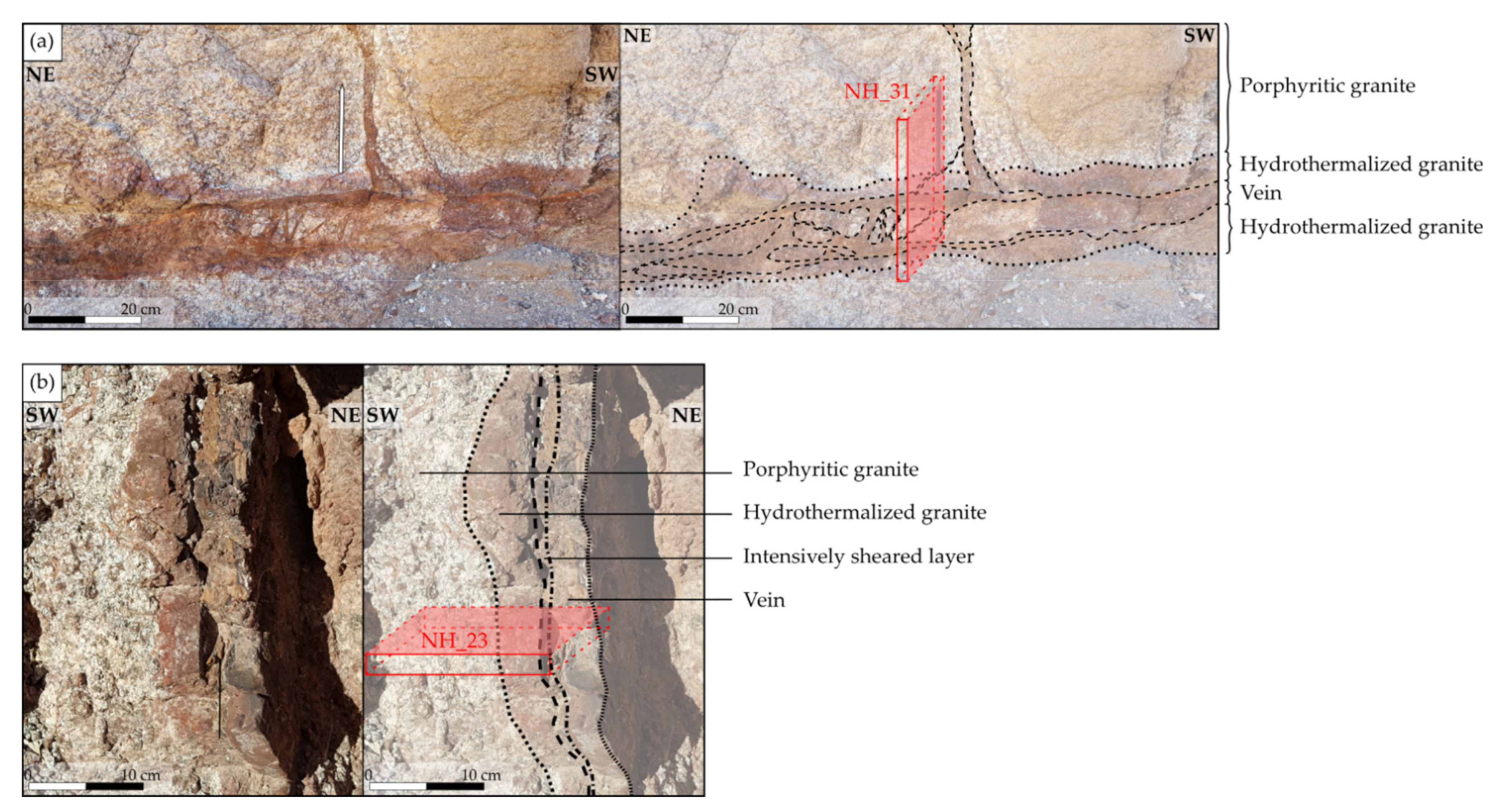
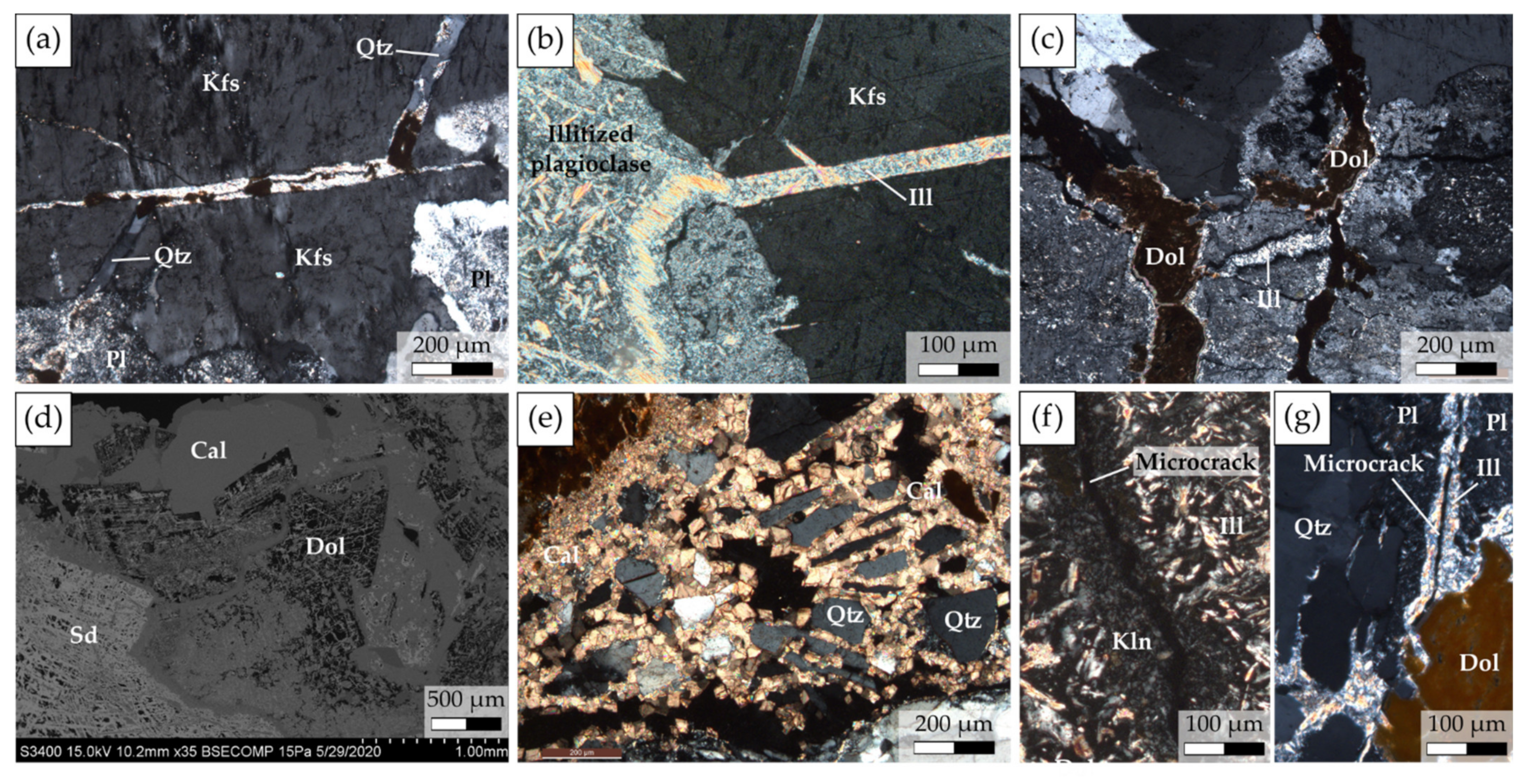
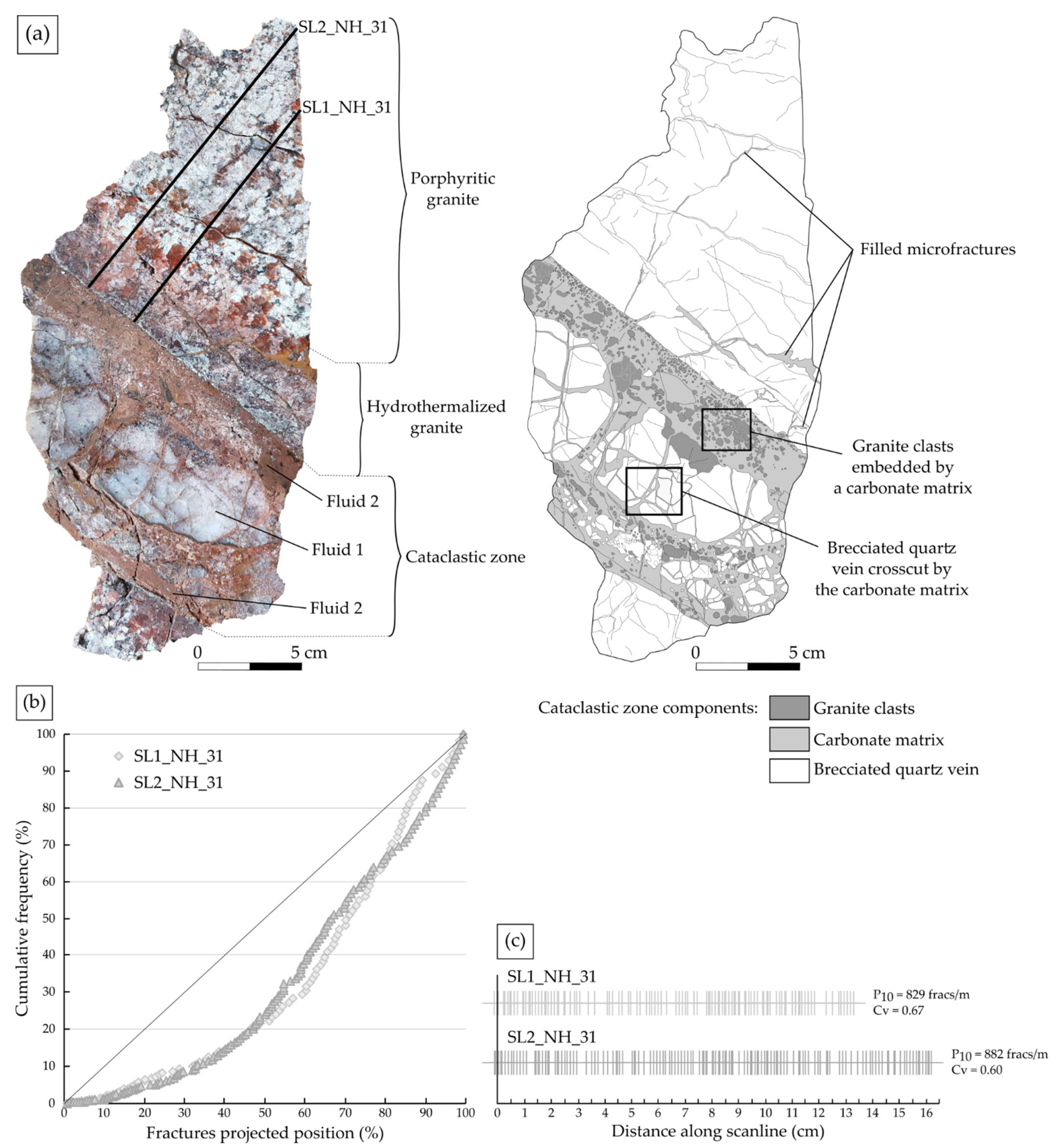

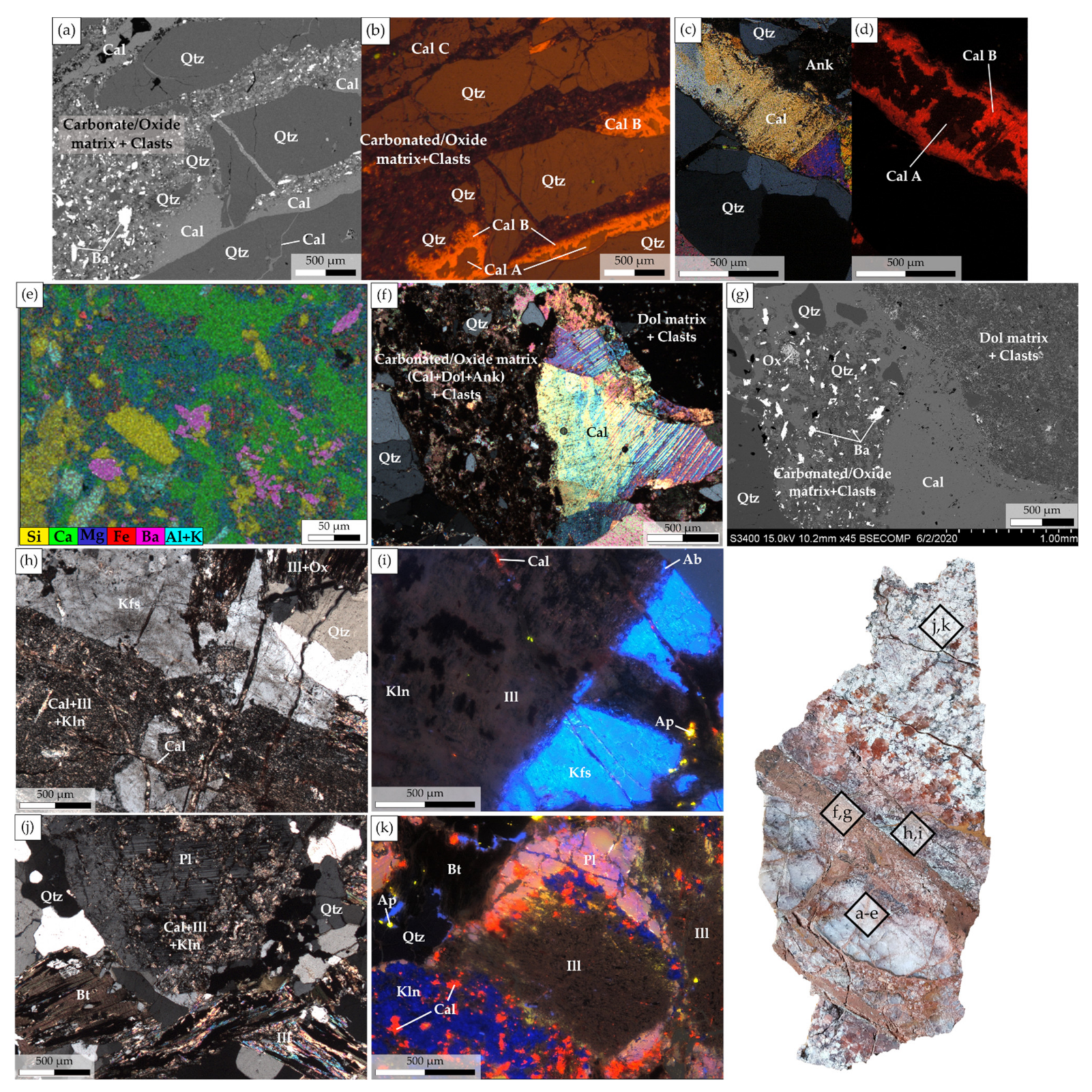
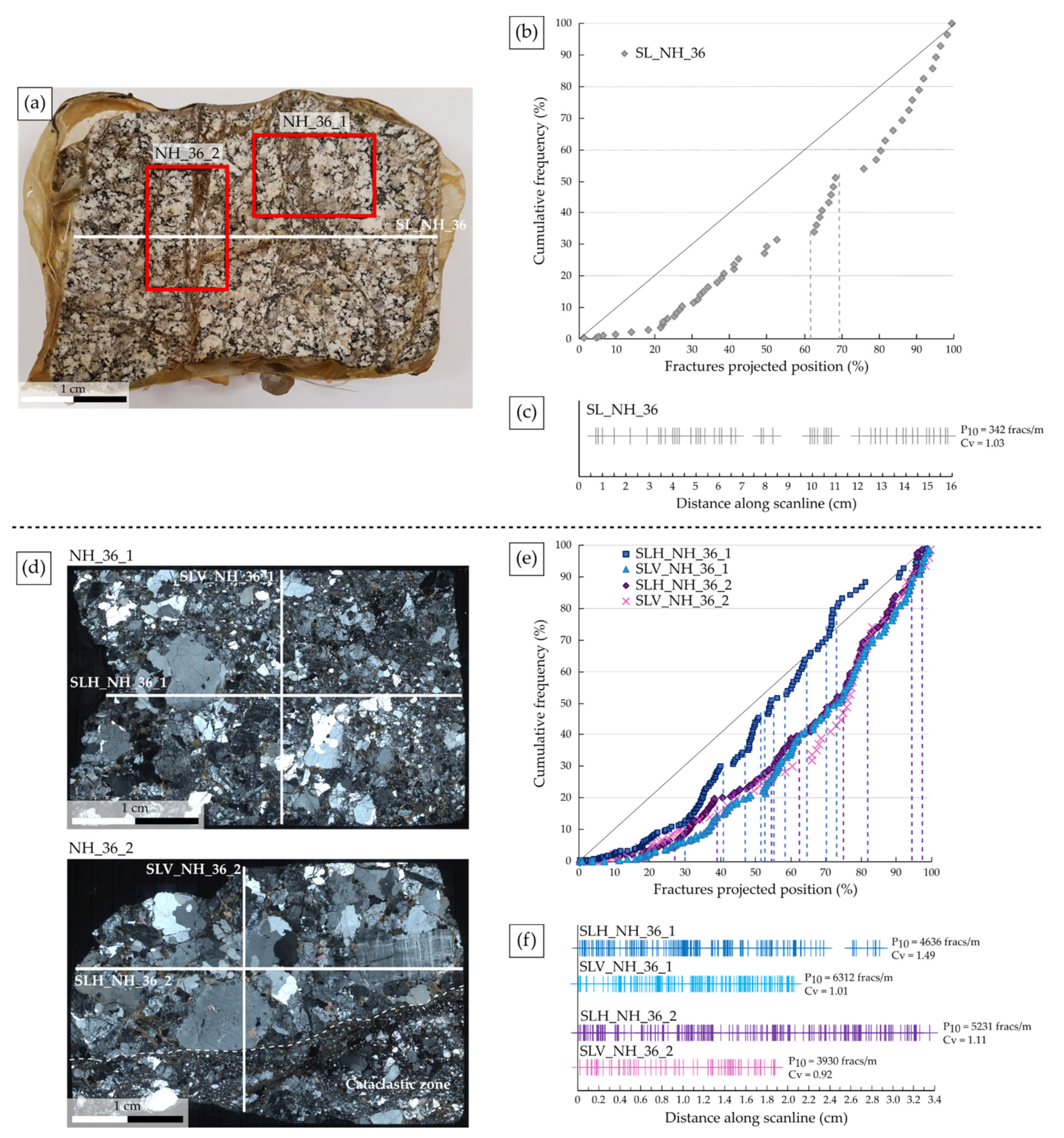
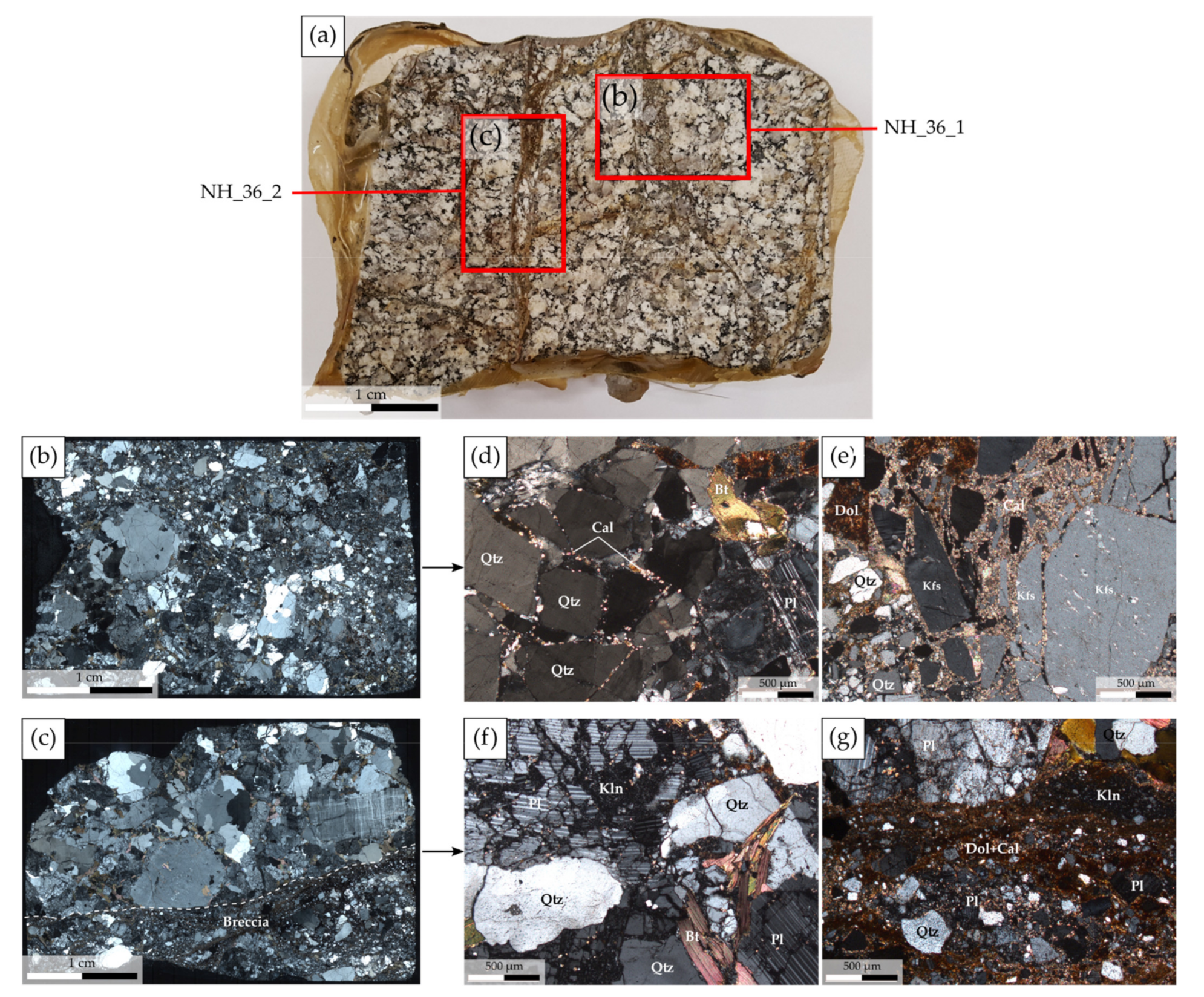
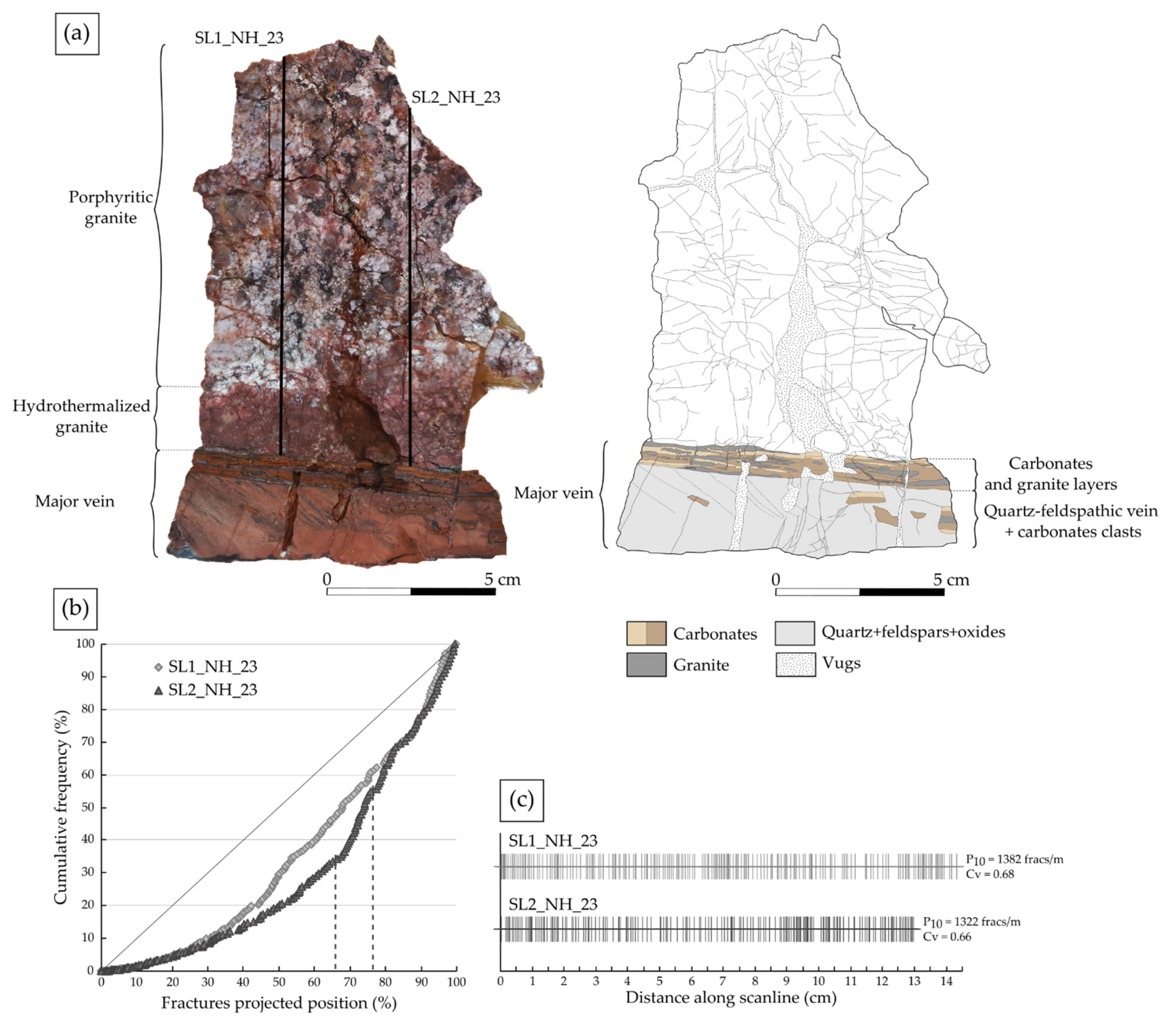
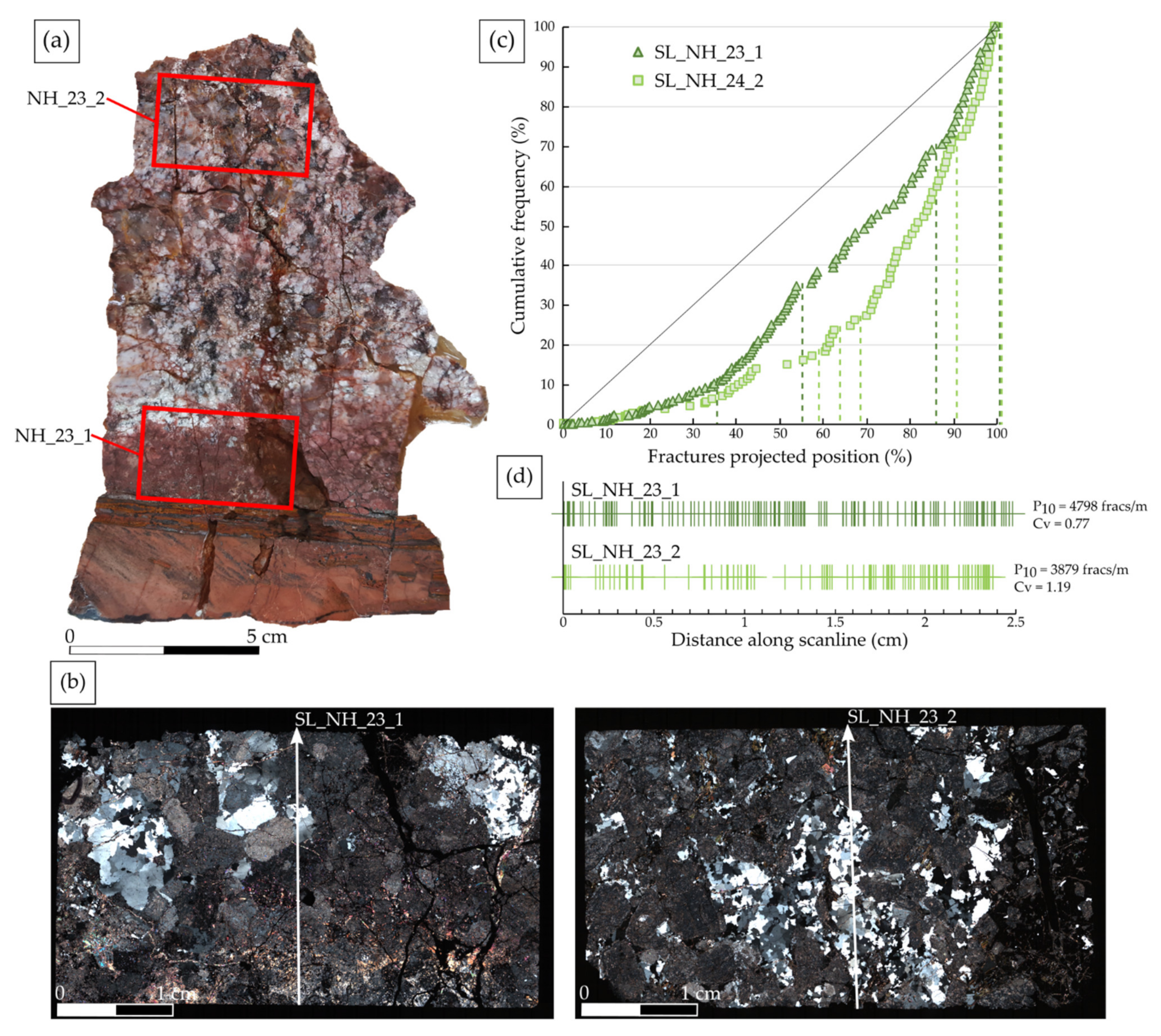
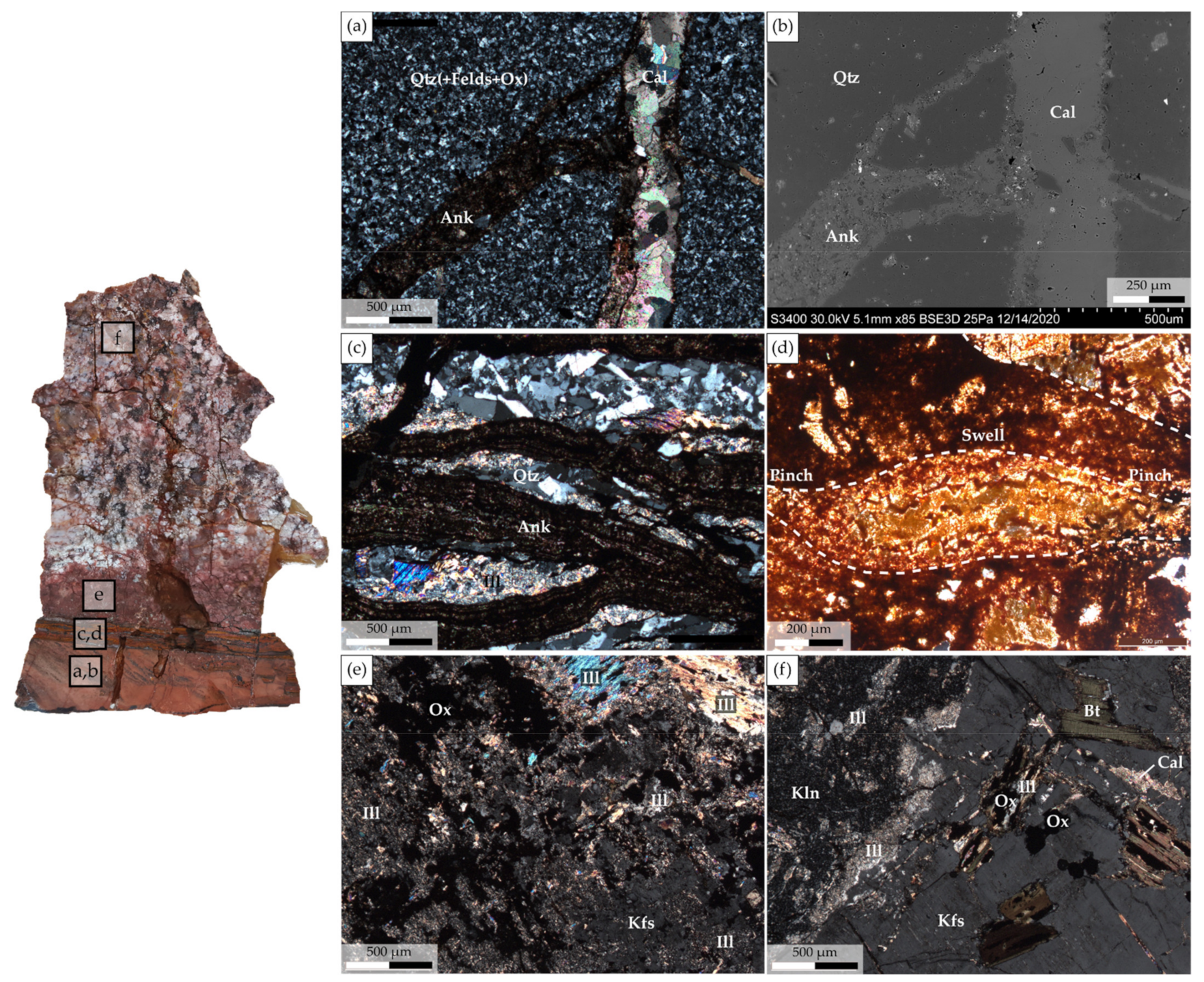

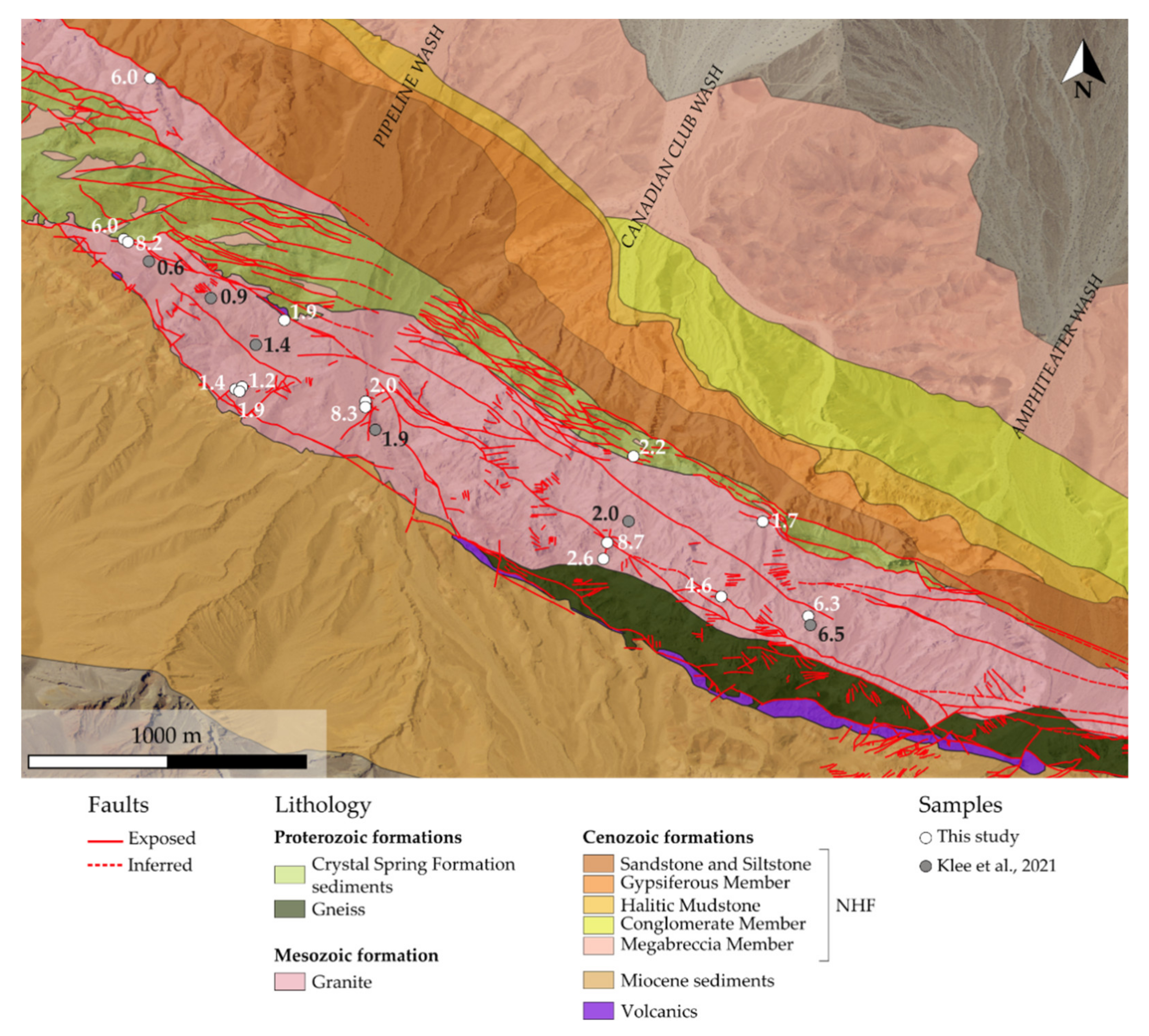
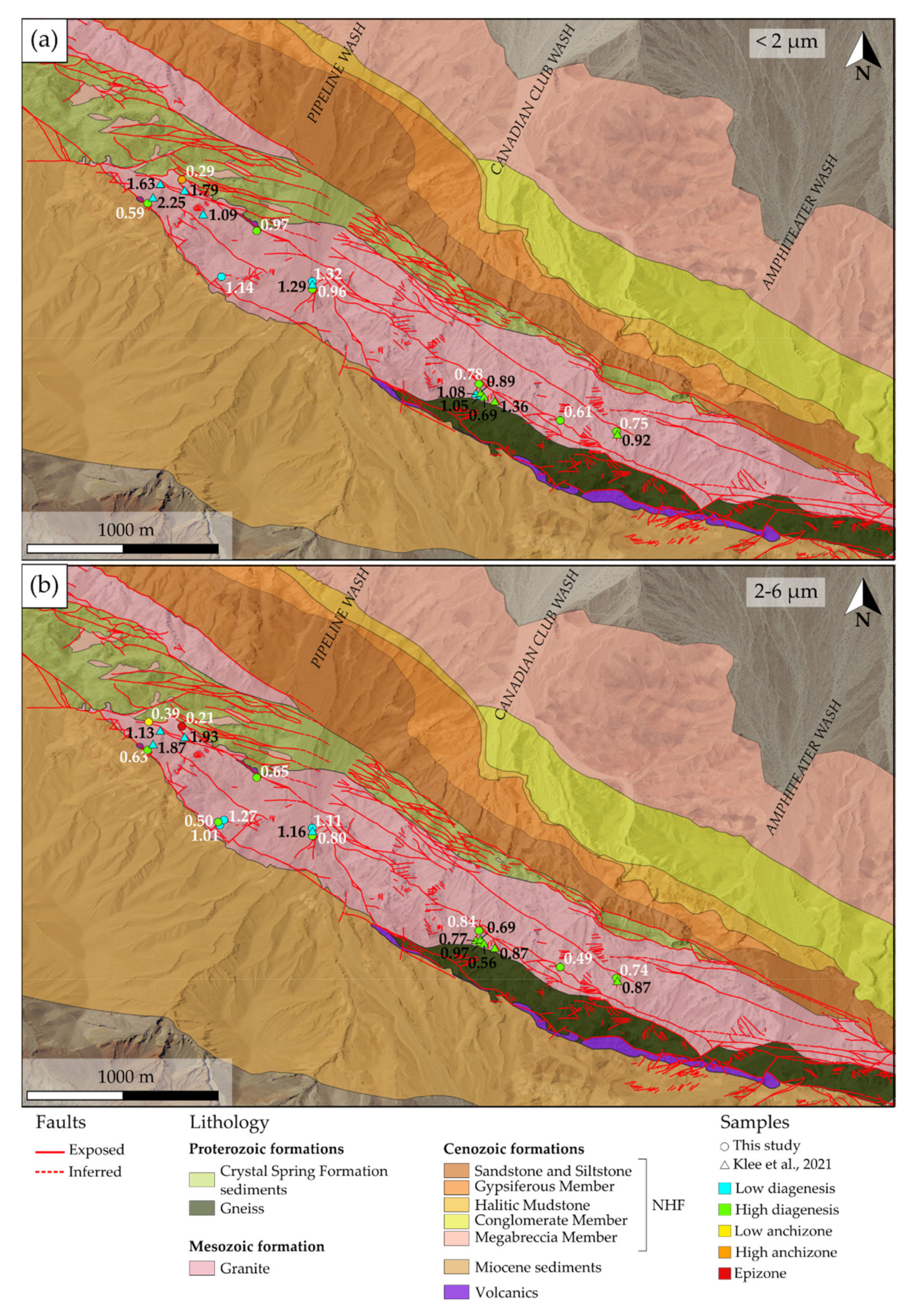
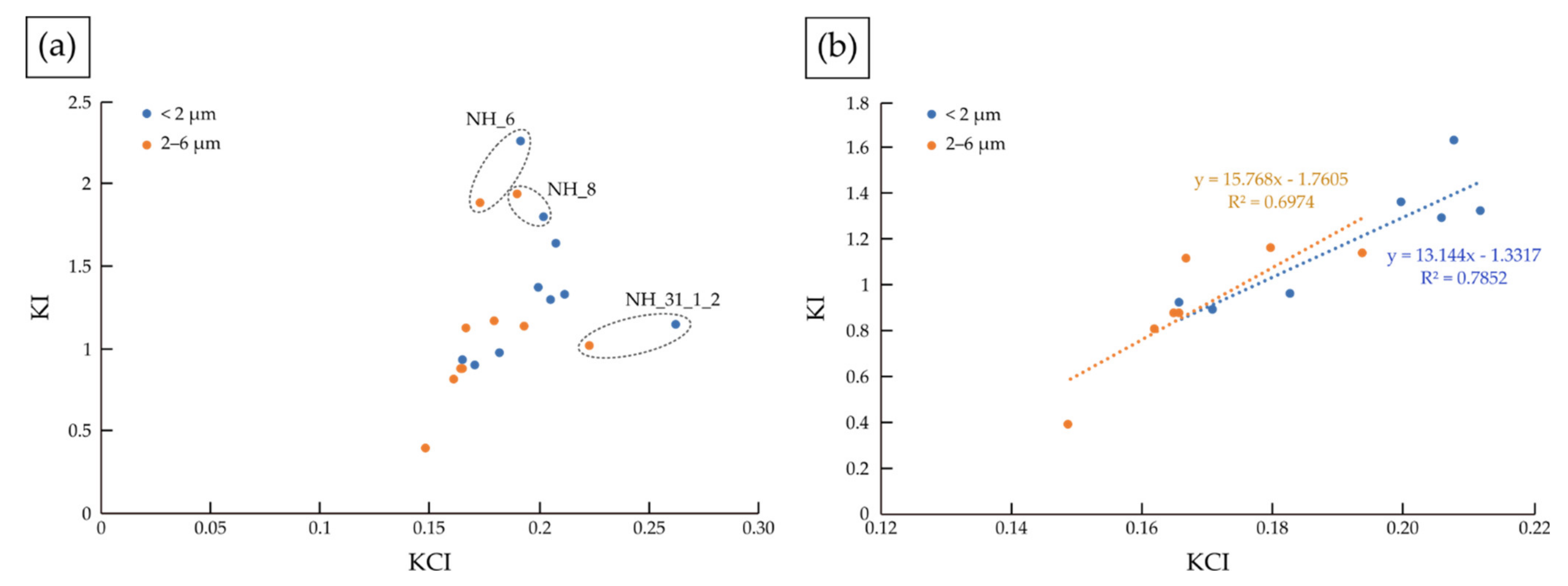

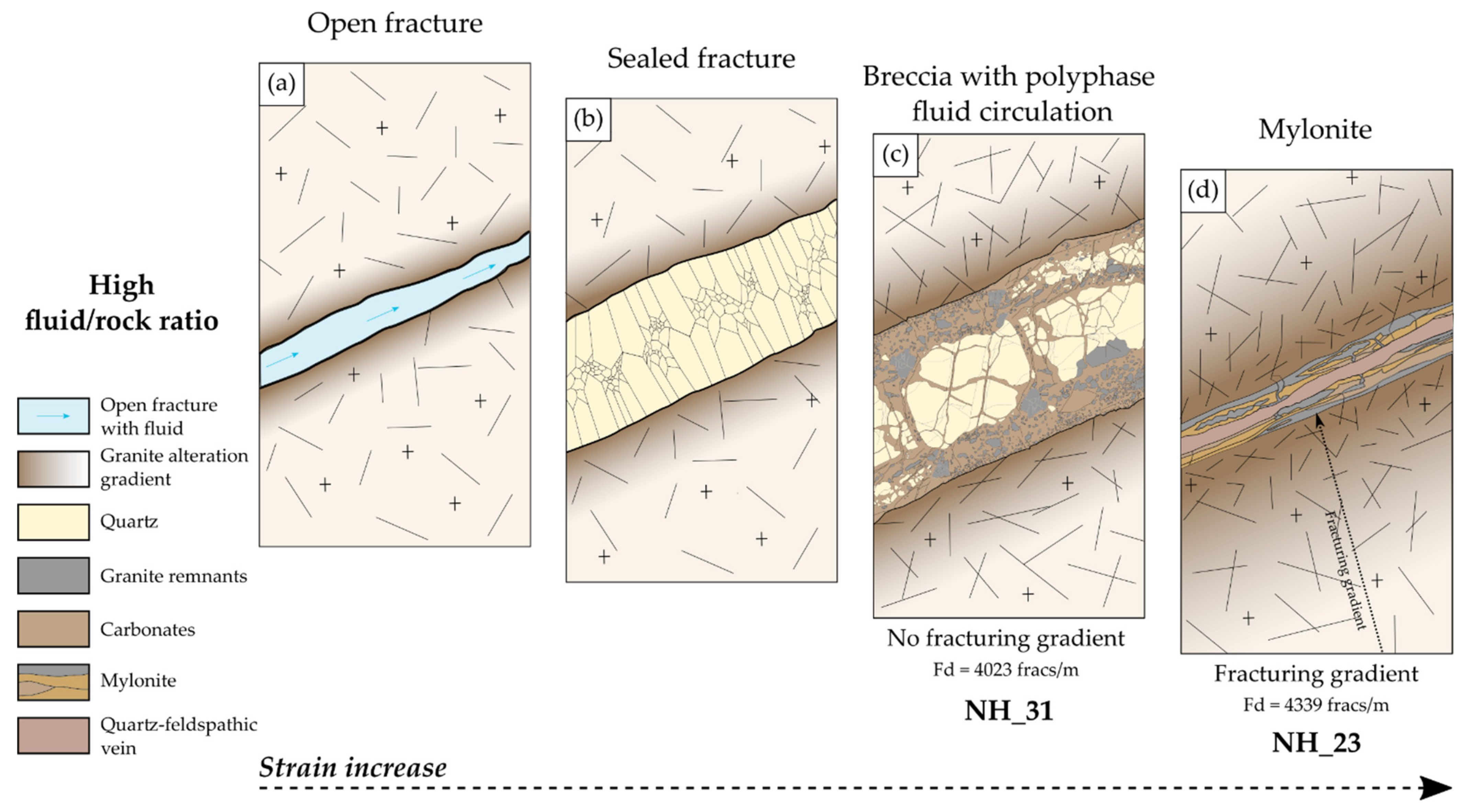
| Sample Name | Primary Minerals | Secondary Minerals | Clay Fraction < 2 µm | Clay Fraction 2–6 µm | Microfracturing | ||||||||||
|---|---|---|---|---|---|---|---|---|---|---|---|---|---|---|---|
| Ill/Ms | Kln | C/S | I/S | Vrm | Bt | Ill/Ms | Kln | C/S | I/S | Vrm | Bt | ||||
| NH_16 | Qtz, Or, Bt, Olg | Cal, Clays | + | - | -- | + | + | -- | Fd2 | ||||||
| NH_17 | Qtz, Or, Ab, Ap | Gp, Clays | n.m. | + | - | -- | Fd2 | ||||||||
| NH_18 | Qtz, Or, Olg, Bt | Clays | ++ | -- | ++ | -- | Fd2 | ||||||||
| NH_19 | Mc, Or, Olg, Bt, Qtz, Ms | Dol, Cal, Clays | + | + | Fd2–3 | ||||||||||
| NH_20 | Qtz, Or, Olg, Bt | Cal, Ox, Clays | n.a. | n.a. | Fd2–3 | ||||||||||
| NH_21 | Qtz, Or, Olg | Cal, Dol, Sd, Ox, Clays | n.a. | n.a. | Fd3 | ||||||||||
| NH_22 | Qtz, Or, Bt, Olg | Cal, Hem, (Dol), Clays | + | - | - | + | - | - | Fd3 | ||||||
| NH_23 | Qtz, Or, Olg, Bt | Cal, Ox, Clays | n.a. | n.a. | Fd3 | ||||||||||
| NH_24 | Qtz, Or, Olg, Bt | Cal, Clays | + | + | - | - | - | + | - | - | Fd3 | ||||
| NH_25 | Qtz, Or, Bt, Ep | Cal, Ox, Clays | ++ | ++ | Fd3 | ||||||||||
| NH_26 | Qtz, Or, Bt, Olg, Mc | Clays | - | ++ | + | + | - | ++ | + | + | Fd3 | ||||
| NH_27 | Qtz, Or, Bt | Ank, Cal, Clays | + | ++ | - | - | + | ++ | - | - | Fd3 | ||||
| NH_28 | Qtz, Or, Mc, Olg, Bt, Ms | Cal, Ox, (Dol), Clays | ++ | ++ | Fd3 | ||||||||||
| NH_29 | Qtz, Or, Olg, Ab, Bt | Cal, Dol, Clays | n.a. | n.a. | Fd3 | ||||||||||
| NH_30 | Qtz, Or, Mc, Olg, Ab, Bt, Ms | Cal, (Ox, Dol), Clays | n.a. | n.a. | Fd3 | ||||||||||
| NH_31_1_2 | Qtz, Or, Olg, Bt | Clays | + | + | - | + | ++ | - | Fd3 | ||||||
| NH_31_3 | Qtz, Or, Ab, Bt | Gp, Cal, Clays | n.m. | ++ | -- | Fd3 | |||||||||
| NH_32 | Qtz, Or, Bt | Cal, Ox, (Dol), Clays | + | ++ | - | + | ++ | - | Fd4 | ||||||
| NH_33 | Qtz, Or, Bt, Ab | Cal, Clays | -- | ++ | -- | - | -- | ++ | -- | - | Fd4 | ||||
| NH_34 | Qtz, Or, Mc, Ab, Ap, Bt | Gp, Cal, Hem, Clays | n.m. | -- | ++ | -- | Fd4 | ||||||||
| NH_35 | Qtz, Or, Mc, Bt | Cal, Clays | n.a. | n.a. | Fd4 | ||||||||||
| NH_36 | Qtz, Or, Bt, Olg | Cal, Gp, Hl, Clays | + | + | ++ | - | Fd4 | ||||||||
| NH_37 | Qtz, Or | Cal, Dol, Ank, Ox, Clays | n.a. | n.a. | Fd4 | ||||||||||
| NH_38 | Qtz, Or, Mc, Olg, Bt | Cal, Clays | ++ | ++ | Fd4 | ||||||||||
| NH_39 | Qtz, Or, Mc, Olg, Bt | Cal, Clays | ++ | ++ | Fd4 | ||||||||||
| Sample Name | Scale | Scanline Name | Scanline Length (cm) | Fracture Number | Mean Spacing (cm) | P10 (fracs/m) | Cv | Fracture Distribution |
|---|---|---|---|---|---|---|---|---|
| NH_31 | Sample | SL1_NH_32 | 13.51 | 111 | 0.12 | 829 | 0.67 | Regular—Random |
| SL2_NH_32 | 16.44 | 144 | 0.11 | 882 | 0.60 | Regular—Random | ||
| Thin sections | SL_NH_32_1 | 1.60 | 47 | 0.03 | 2997 | 1.03 | Random | |
| SL_NH_32_2 | 2.21 | 87 | 0.02 | 3988 | 1.07 | Random—Clustered | ||
| SL_NH_32_3 | 2.34 | 118 | 0.02 | 5084 | 1.11 | Random—Clustered | ||
| NH_36 | Samples | SL_NH_36 | 15.8 | 53 | 0.3 | 342 | 1.03 | Random |
| Thin sections | SLH_NH_36_1 | 2.87 | 153 | 0.02 | 4636 | 1.49 | Clustered | |
| SLV_NH_36_1 | 2.06 | 133 | 0.02 | 6312 | 1.01 | Random | ||
| SLH_NH_36_2 | 3.35 | 184 | 0.02 | 5231 | 1.11 | Random—Clustered | ||
| SLV_NH_36_2 | 1.88 | 74 | 0.03 | 3930 | 0.92 | Regular—Random | ||
| NH_23 | Sample | SL1_NH_24 | 14.33 | 197 | 0.07 | 1382 | 0.68 | Regular—Random |
| SL2_NH_24 | 12.93 | 170 | 0.07 | 1322 | 0.66 | Regular—Random | ||
| Thin sections | SL_NH_24_1 | 2.48 | 117 | 0.02 | 4798 | 0.77 | Regular—Random | |
| SL_NH_24_2 | 2.37 | 91 | 0.02 | 3879 | 1.19 | Random—Clustered |
| Sample ID | NH_19 | NH_23 | NH_27 | NH_31_3 | NH_36 |
|---|---|---|---|---|---|
| SiO2 | 67.18 | 60.84 | 56.26 | 69.29 | 66.67 |
| Al2O3 | 15.03 | 17.31 | 14.05 | 15.42 | 15.30 |
| Fe2O3 | 2.93 | 4.61 | 3.17 | 2.69 | 3.65 |
| MgO | 0.71 | 1.06 | 0.89 | 0.24 | 0.97 |
| CaO | 1.81 | 2.83 | 9.10 | 2.34 | 3.80 |
| Na2O | 2.20 | 2.45 | 0.27 | 2.89 | 3.12 |
| K2O | 5.45 | 4.69 | 4.48 | 4.05 | 3.05 |
| TiO2 | 0.23 | 0.39 | 0.29 | 0.24 | 0.34 |
| P2O5 | 0.12 | 0.18 | 0.14 | 0.13 | 0.17 |
| MnO | 0.11 | 0.23 | 0.23 | 0.06 | 0.12 |
| LOI | 4.10 | 5.20 | 10.90 | 2.50 | 2.60 |
| Sum | 99.91 | 99.88 | 99.90 | 99.88 | 99.87 |
| Sample ID | NH_2 1 | NH_27 | NH_31_3 | NH_36 |
|---|---|---|---|---|
| Porosity (%) | 2.29 | 10.1 | 10.1 | 11.5 |
| Oxides (weight %) | ||||
| SiO2 | 69.57 | 63.3 | 71.18 | 68.6 |
| Al2O3 | 14.72 | 15.81 | 15.84 | 15.74 |
| Fe2O3 | 4.35 | 3.57 | 2.76 | 3.76 |
| MgO | 1.16 | 1 | 0.25 | 1 |
| CaO | 2.53 | 10.24 | 2.4 | 3.91 |
| Na2O | 3.23 | 0.3 | 2.97 | 3.21 |
| K2O | 3.65 | 5.04 | 4.16 | 3.14 |
| TiO2 | 0.47 | 0.33 | 0.25 | 0.35 |
| MnO | 0.12 | 0.26 | 0.06 | 0.12 |
| Density ratio (dA/dF) | 0.93 | 0.92 | 0.92 | |
| Fv (XAl2O3 = 0) | 1.00 | 1.00 | 1.01 | 1.02 |
| Sample ID | NH_27 | NH_31_3 | NH_36 |
|---|---|---|---|
| Absolute mobility (%) | |||
| SiO2 | −10.39 | −3.54 | −5.32 |
| Al2O3 | 0.06 | −0.18 | −0.29 |
| Fe2O3 | −1.01 | −1.77 | −0.82 |
| MgO | −0.23 | −0.92 | −0.22 |
| CaO | 7.04 | −0.30 | 1.10 |
| Na2O | −2.95 | −0.47 | −0.22 |
| K2O | 1.06 | 0.20 | −0.70 |
| TiO2 | −0.16 | −0.24 | −0.14 |
| MnO | 0.12 | −0.06 | −0.01 |
| Sample ID | Illite Peak (10) <2 µm | Illite Peak (10) 2–6 µm | ||
|---|---|---|---|---|
| FWHM AD | KI AD | FWHM AD | KI AD | |
| NH_16 | 0.62 | 0.97 | 0.43 | 0.65 |
| NH_17 | n.m. | 0.80 | 1.27 | |
| NH_18 | 0.41 | 0.61 | 0.34 | 0.49 |
| NH_19 | 0.52 | 0.75 | 0.51 | 0.74 |
| NH_22 | 0.53 | 0.78 | 0.58 | 0.84 |
| NH_24 | 0.83 | 1.32 | 0.70 | 1.11 |
| NH_25 | 0.59 | 0.59 | 0.63 | 0.63 |
| NH_27 | 0.65 | 0.96 | 0.55 | 0.80 |
| NH_31_1_2 | 0.72 | 1.14 | 0.64 | 1.01 |
| NH_31_3 | n.m. | 0.34 | 0.50 | |
| NH_32 | 0.29 | 0.29 | 0.21 | 0.21 |
| NH_34 | n.m. | 0.28 | 0.39 | |
Publisher’s Note: MDPI stays neutral with regard to jurisdictional claims in published maps and institutional affiliations. |
© 2021 by the authors. Licensee MDPI, Basel, Switzerland. This article is an open access article distributed under the terms and conditions of the Creative Commons Attribution (CC BY) license (https://creativecommons.org/licenses/by/4.0/).
Share and Cite
Klee, J.; Chabani, A.; Ledésert, B.A.; Potel, S.; Hébert, R.L.; Trullenque, G. Fluid-Rock Interactions in a Paleo-Geothermal Reservoir (Noble Hills Granite, California, USA). Part 2: The Influence of Fracturing on Granite Alteration Processes and Fluid Circulation at Low to Moderate Regional Strain. Geosciences 2021, 11, 433. https://doi.org/10.3390/geosciences11110433
Klee J, Chabani A, Ledésert BA, Potel S, Hébert RL, Trullenque G. Fluid-Rock Interactions in a Paleo-Geothermal Reservoir (Noble Hills Granite, California, USA). Part 2: The Influence of Fracturing on Granite Alteration Processes and Fluid Circulation at Low to Moderate Regional Strain. Geosciences. 2021; 11(11):433. https://doi.org/10.3390/geosciences11110433
Chicago/Turabian StyleKlee, Johanne, Arezki Chabani, Béatrice A. Ledésert, Sébastien Potel, Ronan L. Hébert, and Ghislain Trullenque. 2021. "Fluid-Rock Interactions in a Paleo-Geothermal Reservoir (Noble Hills Granite, California, USA). Part 2: The Influence of Fracturing on Granite Alteration Processes and Fluid Circulation at Low to Moderate Regional Strain" Geosciences 11, no. 11: 433. https://doi.org/10.3390/geosciences11110433
APA StyleKlee, J., Chabani, A., Ledésert, B. A., Potel, S., Hébert, R. L., & Trullenque, G. (2021). Fluid-Rock Interactions in a Paleo-Geothermal Reservoir (Noble Hills Granite, California, USA). Part 2: The Influence of Fracturing on Granite Alteration Processes and Fluid Circulation at Low to Moderate Regional Strain. Geosciences, 11(11), 433. https://doi.org/10.3390/geosciences11110433








